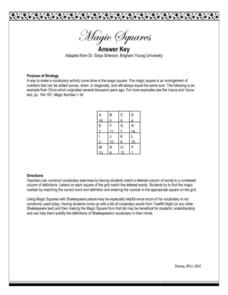Curated OER
Much Ado About Nothing: Guided Imagery Exercise
“Be glad that all things sort so well.” To make text-to-self connections to Shakespeare’s play, class members engage in a guided imagery exercise prior to reading Act IV, scene i of Much Ado About Nothing (the wedding of Claudio and...
Curated OER
Romeo and Juliet Debate
Who is responsible for the deaths of Romeo and Juliet? After generating a list of the six characters most responsible, class members prepare for and engage in a formal debate. Prior knowledge of basic rules for debate would be necessary.
Curated OER
The Portrayal of the Witches
Eleventh graders discover the importance of the fortune teller in Shakespeare's Macbeth. After watching two interpretations of the play, they examine and compare the portrayal of the character. They create their own modern adaptation of...
Curated OER
So Foul and Fair a Play
Students watch various interpretations of Shakespeare's Macbeth in film. In groups, they examine the setting, characters, music and sequence. They compare and contrast the various films and discuss the differences. They write an essay on...
Curated OER
Close Reading
Eleventh graders read and study Hamlet. Then they are introduced to close reading as a means of understanding what is being read--not only understanding the printed word, but also the nuances and connotations of language as it is used by...
Curated OER
"Some Excellent Dumb Discourse:" Caliban as native American
Explore The Tempest and how language and power are intertwined in the play. Through a series of questions (provided) and an intense activity that has groups translate Caliban's speech into American Sign Language, learners recognize...
Curated OER
Julius Caesar List 2 Vocabulary Worksheet
Even for an honors class, there are a lot of difficult vocabulary words in Julius Caesar. Provide your class with this two-page vocabulary guide (text selection unspecified). Two exercises encourage a deeper understanding of words like...
Curated OER
Romanticism: Roots of Modernity
What were the changes in art during the Romantic period? The presentation starts by describing some of the common characteristics of Romanticism, and then several slides present examples from the era. Consider using this in an art or...
Curated OER
Romeo and Juliet List 3 Vocabulary
Provided here is the third list of many for Romeo and Juliet. Twenty new vocabulary terms are introduced like masque, coy, and dirge. Through short-answer questions and fill in the blanks, your readers will develop the vocabulary...
Curated OER
Macbeth List 1 Worksheet
Even by using context clues, readers won't understand all of the language in Macbeth. Prepare them for some of the tricky language in the beginning by providing them with this two-page vocabulary activity. Twenty new words are introduced...
Curated OER
Programs for Shakespeare's Plays
Students design theater programs which show their understanding of William Shakespeare's plays. They design original art to include in the programs.
Curated OER
Twelfth Night Magic Square
Reading Twelfth Night? Words drawn from Shakespeare's comedy provide the words for a Magic Square vocabulary exercise. Directions for how to craft Magic Squares are included.
Curated OER
Macbeth List 3 Worksheet
Reading Macbeth is tough, especially when such challenging vocabulary appears on every page! Don't send your class in blind; prepare them for intense reading by focusing on some of the more challenging vocabulary terms. Included here are...
Curated OER
Themes and Motifs in Macbeth Act Five
How do themes and motifs build and develop through Act Five of Macbeth? With this two-page worksheet, readers record quotations that represent themes like ambition, conscience, and manhood. In addition, they speak to symbols like blood,...
Curated OER
Macbeth List 2 Worksheet
The best way to learn vocabulary is to see it in context, right? That's exactly what this worksheet does; it presents 20 terms for Macbeth in context. For part one, learners answer a list of questions that use the target vocabulary. In...
Curated OER
Measure for Measure Act II, Scene 2 Vocabulary Magic Squares
Readers of Measure for Measure use words from Act II, scene 2 to complete a magic squares vocabulary exercise. An answer sheet is included.
Curated OER
What's in a Name? Considering the Shakespeare Authorship Question
Did Shakespeare really write all that stuff? After viewing a trailer for the film, Anonymous and reading Stephen Marche’s article “Wouldn’t It Be Cool If Shakespeare Wasn’t Shakespeare?” class groups read articles about the Shakespeare...
Curated OER
Hamlet Word Search
If you're looking for a quick time filler, pass out this worksheet. High schoolers find the names of the characters introduced in Hamlet in a word search. An answer page is not provided, but it appears to be challenging as the print is...
Curated OER
Measure for Measure: Act III Scene I
Read this lesser-known play by William Shakespeare. When you get to Act III, provide your class with this two-page learning exercise. First, encourage a self-to-text connection by having individuals record their top 10 priorities. Then,...
Curated OER
Hamlet Anticipation Guide
Here's a short anticipation guide for Hamlet. Before reading the text, learners will mark the things they believe will happen in the text. Then, after they read, they will revisit the guide to see what actually happened.
Curated OER
Shakespeare Quiz 1
In this Shakespeare worksheet, learners identify the characters in the novels written by the famous author. Students complete 20 short answer questions.
Curated OER
Shakespeare Quiz 3
In this Shakespeare Quiz 3 activity, students answer 20 trivia-style questions about Shakespearean plays, then scroll down to check their answers.
Curated OER
Shakespeare and The Globe
A PowerPoint fill-in-the-blanks exam that tests learners knowledge of the life and times of William Shakespeare? Why not? The presentation could be used as a general review or as an introductory activity to assess prior knowledge.
Curated OER
It's All in the Way You Say It
High schoolers unearth multiple meanings based on connotation and cadence. After defining denotation, connotation, and cadence, readers evaluate similar words to compare connotations. They then play with how cadence affects meaning by...

























